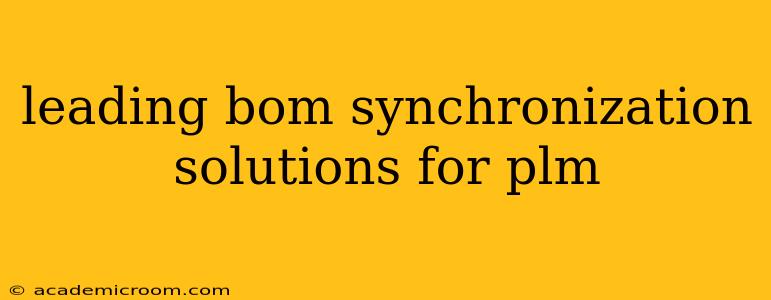Managing Bills of Materials (BOMs) effectively is crucial for any company operating in the Product Lifecycle Management (PLM) space. Inaccurate or outdated BOMs can lead to significant production delays, increased costs, and even product recalls. This is where robust BOM synchronization solutions come into play. These solutions automate the process of keeping BOM data consistent across various systems and departments, improving collaboration and efficiency. This article explores leading BOM synchronization solutions, focusing on their key features and benefits for PLM.
What is BOM Synchronization in PLM?
BOM synchronization in PLM refers to the automated process of ensuring that BOM data is consistent across all relevant systems and departments within an organization. This includes syncing data between PLM systems, ERP (Enterprise Resource Planning) systems, and other relevant applications. Manual BOM updates are prone to errors and inconsistencies. Automated synchronization eliminates this risk, ensuring accuracy and reducing the potential for costly mistakes.
Key Features of Leading BOM Synchronization Solutions:
Leading BOM synchronization solutions typically offer a range of features designed to streamline the process and enhance accuracy. These include:
- Real-time Synchronization: This ensures that BOM data is always up-to-date across all systems, minimizing the risk of discrepancies.
- Automated Data Mapping: This automates the process of mapping data fields between different systems, simplifying the integration process.
- Change Management: Effective change management features allow for controlled updates and tracking of modifications to the BOM, ensuring accountability and traceability.
- Data Validation: This feature checks for errors and inconsistencies in the BOM data before synchronization, preventing the propagation of incorrect information.
- Conflict Resolution: Solutions often include sophisticated mechanisms to handle conflicts that might arise when updating BOMs from multiple sources.
- Reporting and Analytics: Comprehensive reporting capabilities offer visibility into BOM data, enabling users to track key metrics and identify areas for improvement.
- Integration with other PLM systems: Seamless integration with leading PLM platforms is essential for a truly effective solution.
How to Choose the Right BOM Synchronization Solution?
Selecting the right BOM synchronization solution requires careful consideration of your specific needs and requirements. Key factors to consider include:
- System Compatibility: Ensure the solution is compatible with your existing PLM, ERP, and other relevant systems.
- Scalability: Choose a solution that can scale to meet your future needs as your business grows.
- Integration Capabilities: Evaluate the solution's ability to integrate with other systems and applications.
- User Friendliness: A user-friendly interface is crucial for ensuring adoption and maximizing efficiency.
- Cost: Consider the total cost of ownership, including licensing fees, implementation costs, and ongoing maintenance.
What are the Benefits of Implementing a BOM Synchronization Solution?
Implementing a robust BOM synchronization solution offers numerous benefits, including:
- Improved Data Accuracy: Automated synchronization reduces the risk of human error, leading to more accurate BOM data.
- Enhanced Collaboration: It improves collaboration among different departments by providing a single source of truth for BOM information.
- Reduced Costs: By minimizing errors and delays, it significantly reduces production costs.
- Faster Time-to-Market: Improved data accuracy and streamlined processes contribute to faster product launches.
- Increased Efficiency: Automation frees up valuable time and resources, allowing teams to focus on higher-value tasks.
- Improved Product Quality: Accurate BOM data helps to ensure that products are manufactured to the correct specifications.
What are the different types of BOM synchronization?
There are several types of BOM synchronization strategies, each with its own advantages and disadvantages. The optimal choice depends on your specific requirements and IT infrastructure. These might include:
- Real-time Synchronization: Provides immediate updates, ensuring data consistency at all times. This is generally preferred but can place higher demands on system resources.
- Scheduled Synchronization: Updates are performed at predetermined intervals, offering a balance between real-time accuracy and system load.
- Event-Triggered Synchronization: Updates occur only when specific events take place, such as a BOM change in the primary system. This is efficient but might introduce minor delays.
How do I ensure successful BOM synchronization implementation?
Successfully implementing a BOM synchronization solution requires careful planning and execution. Key steps include:
- Needs Assessment: Clearly define your requirements and goals.
- Solution Selection: Choose a solution that meets your needs and integrates seamlessly with your existing systems.
- Data Migration: Carefully plan and execute the data migration process to ensure data integrity.
- Testing and Validation: Thoroughly test the solution before full deployment to identify and resolve any issues.
- Training and Support: Provide adequate training to users and ensure ongoing support is available.
By carefully considering these aspects and selecting a robust BOM synchronization solution, companies can significantly improve their PLM processes, reduce errors, and gain a competitive edge. The right solution will streamline your operations, enhance collaboration, and ultimately drive greater success in the fast-paced world of product development.
